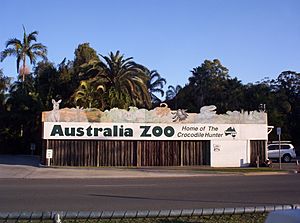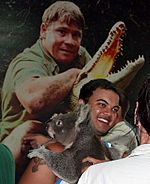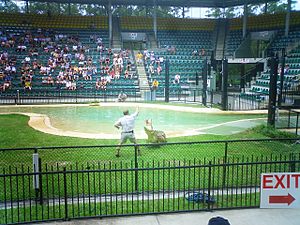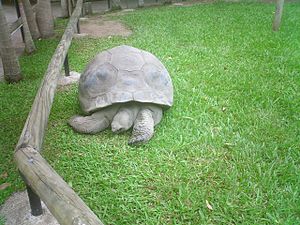Australia Zoo facts for kids
 |
|

Australia Zoo entrance
|
|
| Date opened | 3 June 1970 |
|---|---|
| Location | Beerwah, Queensland, Australia |
| Land area | 1,000 acres (400 ha) |
| Coordinates | 26°50′12″S 152°57′34″E / 26.8366°S 152.9595°E |
| No. of animals | 1000+ |
| Annual visitors | 700,000 |
| Memberships | ZAA |
Australia Zoo is a huge zoo in Queensland, Australia. It covers about 1,000 acres! You can find it on the Sunshine Coast near Beerwah.
The zoo is part of the Zoo and Aquarium Association (ZAA). It is owned by Terri Irwin, who was married to the famous Steve Irwin. Steve Irwin's TV show, The Crocodile Hunter, helped make the zoo very popular. The zoo is currently run by Director Wes Mannion.
Australia Zoo first opened on June 3, 1970. It was started by Bob and Lyn Irwin. Back then, it was called the Beerwah Reptile and Fauna Park. Their son, Steve, helped his parents from a young age. He cared for the crocodiles and other animals.
In 1982, the park changed its name to the Queensland Reptile and Fauna Park. It also grew bigger, adding another 4 acres. Later, Steve and Terri changed the name again to Australia Zoo. They used money from their TV shows and merchandise to help protect animals and build new areas at the zoo.
Australia Zoo has won awards, like the Australian Tourism Awards in 2003–2004. In 2004, the Australian Animal Hospital opened next to the zoo. This hospital helps sick and injured animals. Visitors to the zoo can see many different birds, mammals, and reptiles. You can even watch crocodile feedings or hand-feed elephants!
In 2009, Australia Zoo was named one of Queensland's "Q150 Icons." This was for its important role as a special place in the state.
Contents
History of Australia Zoo
How it Started (1970–1992)
Australia Zoo began as the Beerwah Reptile Park. It was opened by Bob and Lyn Irwin on June 3, 1970. Bob was a famous expert on reptiles. Lyn was one of the first people to care for injured wildlife in southeast Queensland.
Bob and Lyn taught their children, including Steve, to love and respect animals. Steve helped his parents care for crocodiles and other reptiles. He also helped look after the growing number of animals at the park.
In 1982, the park was renamed the Queensland Reptile and Fauna Park. It also doubled in size. In 1987, the Crocodile Environmental Park opened. This park helped protect saltwater crocodiles. By the 1990s, the Crocodile Environmental Park was very popular. People loved watching the crocodile feedings there. This area mainly housed adult saltwater crocodiles that had been caught in the wild and moved to the park.
Growing Bigger (1992–2006)
The 1990s brought many changes. Bob and Lyn retired. Steve and Terri took over the park. In 1998, they changed its name to Australia Zoo.
Steve and Terri used all the money from their TV shows and merchandise for animal conservation. They also used it to build new exhibits. Their main belief was that the animals came first. The zoo team came second, and the visitors came third. The zoo also grew its team, hiring about 50 staff members.
Australia Zoo won the Australian Tourism Award in 2003-2004. It was named a "Major Tourist Attraction." In 2004, the Australian Animal Hospital opened next to the zoo. It helps care for and heal animals. This hospital was built in an old avocado shed. It was named after Lyn Irwin. The hospital had one operating room. It had 20 full-time staff and 80 volunteers. They cared for up to 6,000 animals each year.
Steve Irwin passed away in 2006. In the same year, Australia Zoo Retail won an award for tourism retailing.
Recent Years (2007–Present)
In 2007, the zoo and the Queensland Government made a land deal. This deal helped the zoo get land to expand. It allowed them to plan a large safari attraction. This would help the zoo become even more world-class.
In 2008, a new $5 million animal hospital opened. It was said to be the biggest wildlife hospital in the world. This new hospital is very large, covering about 1,300 square meters. It has two operating rooms where students can watch. It also has two treatment rooms and special care units for different animals. There's even a CAT scan room.
On March 2, 2008, Bob Irwin, the zoo's founder, stepped down from Australia Zoo. He wanted to continue his son's dream on a different property.
There were some rumors in 2008 about selling Australia Zoo. However, Terri Irwin said she had no plans to sell it. She wanted to expand the park instead. Terri also became an Australian citizen in 2009.
By 2010, the zoo had grown to 76 acres. There are plans to add a 135-hectare safari park with a hotel in the future. Due to economic challenges, some expansion plans were paused.
During the bushfires in 2019 and early 2020, the Wildlife Hospital treated its 90,000th injured animal.
How Australia Zoo is Managed
The zoo is managed by Director Wes Mannion. Australia Zoo Pty Ltd owns the business. However, a company called Silverback Properties Pty Ltd owns the land where the zoo is located. Other companies manage the food courts and shops at the zoo.
Animals at Australia Zoo
The zoo is home to many different birds, mammals, and reptiles.
Special Animal Exhibits
The Crocoseum

The 'Mount Franklin Crocoseum' is a large stadium at the zoo. It can hold about 5,000 people. When it was built, it was the first place in the world to have shows with snakes, birds, and crocodiles. Australia Zoo calls these shows 'Wildlife Warriors 101'. The stadium also hosts concerts.
Africa Exhibit
In September 2011, the zoo opened its Africa Safari exhibit. This area looks like the Serengeti in Africa. You can see zebras, rhinos, and giraffes living together, just like they would in the wild. Cheetahs are also on display, but in a separate area. The exhibit has trees that look like African baobab trees and rock formations called kopjes.
The zoo is also building an artificial island. This island will look like Madagascar. It will be home to African animals like tortoises and lemurs.
Tiger Temple
The Tiger Temple opened in April 2005. It is home to both Sumatran and Bengal tigers. The exhibit looks like the Angkor Wat temple in Cambodia. It has glass walls on two sides. There is also a special area where you can view the tigers underwater.
Elephantasia
Elephantasia is a large, 12-acre exhibit with an Asian theme. It opened in 2006 and was the biggest Asian elephant home in Australia. It has a wading pool with a fountain and tropical gardens. Australia Zoo stopped having elephants for a while. However, in late 2019, four new Sumatran elephants arrived. They are expected to be on display in Elephantasia by mid-2020.
South-East Asian Precinct
Other Asian animals have exhibits near the Tiger Temple and Elephantasia. These areas are designed to look like their natural homes. You can see animals like Komodo dragons, red pandas, Asian small-clawed otters, and Burmese pythons here.
Rainforest Aviary
The Rainforest Aviary is an outdoor area where you can walk through. It has about 150 birds, mostly from Australia. Next to it is the Birds of Prey aviary. This area holds different kinds of raptors and other hunting birds.
Bindi's Island
Bindi's Island opened in December 2014. It is named after Steve Irwin's daughter, Bindi. It is a three-story "treehouse" built around a fake fig tree. From here, you get great views of Australia Zoo, including the nearby lemur island.
Other Things to See and Do
Food and Dining
Visitors can eat at the open-air "Food Court" in the "Taj Mahal" building. It can seat up to 1,500 people. There's also the Dingo Diner and other food stands around the zoo.
Getting Around
To explore the zoo, you can ride Steve's Safari Shuttle. This is a special bus that travels on a road around the park. You can also rent a caddie to drive yourself around for the day.
Playgrounds
The zoo has two shaded playgrounds for kids to enjoy.
Activities at the Zoo
You can watch crocodile feedings and even help feed the elephants. Elephant feedings happen in the mornings on the roadway and in the afternoons at 'Elephantasia'.
There are four walk-through areas where you can enter and feed kangaroos, wallabies, and koalas. Sometimes, you can even pet a koala when staff are there.
The zoo also has a special animal team that walks around the grounds. They bring different animals like alligators, birds, snakes, and lizards. You can take photos with these animals and buy professional copies.
In April 2019, Australia Zoo announced a new project called 'Camp Croc'. This will be a camping experience where visitors can stay overnight and enjoy wildlife.
Animal Rescue and Care
Wildlife Warriors
Wildlife Warriors is a group that rescues and cares for native wildlife. They help any injured animals found outside the zoo.
The Australia Zoo Wildlife Hospital supports this work. It is next to the zoo and can care for up to 10,000 animals each year. It has two operating rooms, treatment rooms, and special care units for different animals. There's even a CAT scan room. The hospital is named after Steve Irwin's mother, Lyn Irwin.
International Crocodile Rescue (ICR)
The zoo also runs International Crocodile Rescue. This group helps catch and move "problem crocodiles" if needed. They have locations in Australia and around the world. These places are set up to capture and relocate crocodiles safely. The zoo takes in many captured crocodiles if they cannot be released back into the wild. The crocodile rescue unit has a special facility at Australia Zoo for adult saltwater crocodiles.
Croc One
Croc One is Australia Zoo's research boat. It is used around Australia for marine and land research. It was used for the "Crocs in space" program by the University of Queensland. Croc One is also known as the vessel Steve Irwin was on when he passed away. Croc One is kept at the Mooloolaba wharf.
Whale One
Whale One is a special boat used for whale watching at Mooloolaba. It is currently owned and operated by Sunreef, but Australia Zoo used to own it. It is also kept at the Mooloolaba wharf.
Other Conservation Areas
Steve Irwin Wildlife Reserve
This huge property, covering 135,000 hectares, was bought with help from the Australian government. It is located on the Cape York Peninsula in Queensland. It has wetlands fed by springs, which provide water for threatened habitats and the Wenlock River.
Iron Bark Station (Blackbutt)
Australia Zoo bought the 3,500-acre Iron Bark Station in Blackbutt, Queensland, in 1994. This area is part of the Great Dividing Range. In 1994, another 325 acres were bought to help a small koala population. The zoo immediately started planting trees, including 44,000 eucalypt trees for koalas. More land was bought over the years. In 1999, a 5-acre facility was set up to help native marsupials. In 2007, Bob Irwin became the full-time manager of the station.
Heathland
The Zoo bought 250 acres of Australian heathland in 2002. This was to help protect endangered plants and animals in the area. Animals found here include black cockatoos, different types of gliders, acid frogs, echidnas, antechinus, Richmond birdwing butterflies, and platypus.
Mourachan (St. George)
This conservation area was created to protect endangered species. These include the woma python and yakka skink. It covers 117,174 acres. Australia Zoo and the Australia Zoo Wildlife Warriors have created different habitats here. It is a place where endangered species can grow their populations again. In 2015, Terri bought another 33,000 acres to expand this conservation area.
See also
 In Spanish: Zoológico de Australia para niños
In Spanish: Zoológico de Australia para niños




